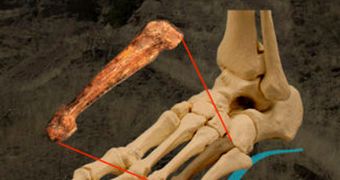Groundbreaking discoveries indicate that the species of hominids to which the famous Lucy skeleton belongs to was bipedal, even though it populated the world some 3.2 million years ago. Furthermore, new studies show that the species' bipedal gait was very human-like.
Scientists searching for fossilized human remains in Hadar, Ethiopia, made the findings that led to this conclusion fairly recently. They discovered a foot bone a while back, and subjected it to a few tests.
It was determined that it belonged to one of our evolutionary ancestors, a species called Australopithecus afarensis, which walked upright more than 3.2 million years ago. Details of the amazing discovery appear in the February 11 issue of the top journal Science.
The midfoot bone (fourth metatarsal) discovered in Ethiopia, provides investigators with an insight into how the early hominids walked. One of the most important things discovered is that A. afarensis had a permanently-arched foot, just like we do.
Such an architecture is absolutely critical for our ability to stand on two feet, and move around without depleting all of our energy reserves. The new study was authored by researchers in the United States.
University of Missouri expert Carol Ward and Arizona State University (ASU) Institute of Human Origins (IHO) scientists William Kimbel and Donald Johanson collaborated to conduct the research.
Until now, some researchers believed that A. afarensis was practicing some sort of hybrid locomotion, somewhere between the quadrupedal tree-climbing of chimpanzees and human terrestrial bipedalism.
“This fourth metatarsal is the only one known of A. afarensis and is a key piece of evidence for the early evolution of the uniquely human way of walking,” Kimbel explains.
“The ongoing work at Hadar is producing rare parts of the skeleton that are absolutely critical for understanding how our species evolved,” he goes on to say. The site is the richest source of A. afarensis fossils ever discovered.
It yielded more than 250 specimens thus far, which were demonstrated to belong to at least 17 different individuals. Locality 333, the area where the foot bone was found, is called the First Family Site.
“Understanding that the foot arches appeared very early in our evolution shows that the unique structure of our feet is fundamental to human locomotion,” Ward says.
“If we can understand what we were designed to do and how natural selection shaped the human skeleton, we can gain insight into how our skeletons work today,” the investigator goes on to say.
“Arches in our feet were just as important for our ancestors as they are for us,” Ward concludes.

 14 DAY TRIAL //
14 DAY TRIAL //